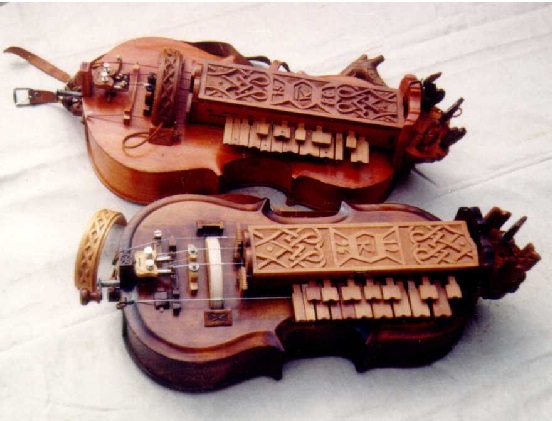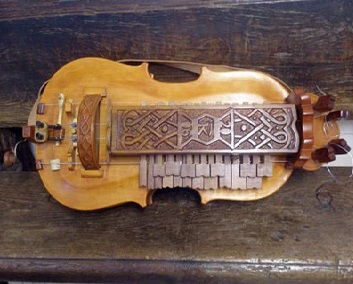Ninera
Bowed Instruments
Europe
Between 1001 and 1900 AD
Video
The Ninera is a captivating musical instrument that has found its place within the rich tapestry of Slovak folk music. Often considered a unique version of the hurdy-gurdy, it embodies a blend of history, craftsmanship, and cultural significance.
The Ninera is a stringed instrument that produces sound through a combination of bowing and mechanical action. It is part of the family of instruments known as hurdy-gurdies, which are characterized by their use of a wheel that rubs against the strings to create sound. The Ninera typically features a wooden body with a distinctive shape that resembles an hourglass or a rounded rectangle. This design contributes to its unique acoustic properties, allowing for a rich and resonant sound. The instrument is played by turning a crank that rotates a wheel, which in turn creates friction against the strings. The player can control the pitch by pressing keys along the instrument’s neck, which act as tangents to shorten the vibrating length of the strings. This mechanism allows for both melody and drone sounds to be produced simultaneously, making the Ninera versatile in its musical capabilities.
History
The origins of the Ninera can be traced back to Europe, specifically Slovakia and the Czech Republic. It is believed to have emerged during the late medieval period, around the 11th century. The hurdy-gurdy itself has roots that extend even further back, likely evolving from early stringed instruments such as fiddles or rebabs found in both Europe and the Middle East. Historically, the Ninera was used primarily in folk music settings. It gained popularity during the Renaissance period when it became a staple in various European musical traditions. The instrument’s unique sound made it particularly well-suited for dance music and communal gatherings. Over time, however, its prominence waned as other instruments gained favor. In Slovakia, the Ninera has maintained its cultural significance despite periods of decline. It has been embraced by folk musicians who seek to preserve traditional music forms while also exploring contemporary styles. Notably, one prominent player of the Ninera is Tibor Koblicek, who has contributed to revitalizing interest in this unique instrument.
How It Works
The working mechanism of the Ninera is fascinating and showcases intricate craftsmanship. At its core, the instrument consists of several key components:
- Wheel: The primary sound-producing element that rotates when cranked.
- Strings: Typically includes one melody string and multiple drone strings.
- Keys: Positioned along the neck to alter pitch by acting as tangents.
When played, turning the crank causes the wheel to spin against the strings, generating sound through friction. The player can press down on keys to change notes while simultaneously producing drone sounds from other strings. This combination allows for complex melodies and harmonies.
Types
While there are variations within hurdy-gurdies globally, the Ninera itself does not have extensive subtypes but can be categorized based on regional styles or specific adaptations made by luthiers. Some common distinctions include:
- Traditional Ninera: Crafted using traditional methods with minimal modern alterations.
- Modern Ninera: Incorporates contemporary materials or design elements for enhanced playability or aesthetic appeal.
Each type maintains its core mechanics but may differ in appearance or tonal characteristics based on construction techniques and materials used.
Features
The Ninera boasts several distinctive features:
- Soundbox Shape: Its unique design contributes to its resonant sound quality.
- Crank Mechanism: Facilitates continuous sound production without requiring constant bowing.
- Key System: Allows for intricate melodic play while maintaining drone tones.
- Construction Materials: Typically made from wood with careful attention to craftsmanship.
These features not only enhance its musical capabilities but also reflect cultural artistry in its construction.
Kind of Music Composed
The music composed for the Ninera primarily falls within traditional Slovak folk genres. Its ability to produce both melody and drone makes it particularly suited for dance music such as polkas and waltzes. Folk ensembles often incorporate the Ninera alongside other instruments like flutes or violins to create rich musical textures.In recent years, contemporary musicians have begun experimenting with the Ninera in various genres beyond traditional folk music. This includes fusion styles that blend elements from different musical traditions, showcasing its versatility as an instrument capable of adapting to modern sounds while retaining its historical roots.
Significance
The significance of the Ninera extends beyond its musical capabilities; it serves as a cultural emblem within Slovakia. As an integral part of folk traditions, it represents community gatherings and celebrations where music plays a vital role in social cohesion.In addition to its cultural importance, efforts have been made to revive interest in traditional instruments like the Ninera among younger generations. Workshops and festivals dedicated to folk music often feature performances with this instrument, fostering appreciation for Slovakia’s rich musical heritage. Moreover, musicians like Tibor Koblicek have played crucial roles in promoting awareness about the Ninera through performances and educational initiatives. Their work not only preserves traditional practices but also inspires new compositions that resonate with contemporary audiences.
The Ninera is more than just an instrument; it embodies a rich history and cultural identity within Slovakia’s musical landscape. Its unique sound and craftsmanship continue to inspire musicians today while serving as a bridge between traditions and modern expressions.
FAQ
What is the history of the Ninera musical instrument?
The Ninera, or hurdy-gurdy, has origins in medieval Europe. It evolved from early string instruments around the 10th century, becoming popular during the Renaissance. Its crank mechanism and keys mimic a violin and keyboard combination. Traditionally used in folk music, it represents diverse cultural traditions.
What are the primary uses of the Ninera instrument?
The Ninera is primarily used in traditional folk music across Europe and Latin America. Its distinctive droning sound complements dances and storytelling. Modern musicians also incorporate it into experimental and world music genres. It’s cherished for its unique timbre and cultural significance.
Where does the Ninera originate from?
The Ninera originates from medieval Europe, with early prototypes emerging in the 10th century. It spread across regions like France, Spain, and Eastern Europe. The instrument's name and variations depend on local traditions. Its design reflects medieval innovation in combining melody and rhythm.
 Links
Links
References
Other Instrument
Categories



















